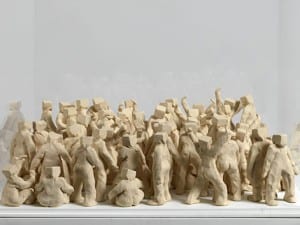For the first time ever, Louise Bourgeois’s series of 38 soft-ground etchings created between 2006 and 2010 are on show together at Hauser & Wirth, Somerset, as part of the exhibition, Turning Inwards. The etchings are accompanied by a selection of the artist’s sculptures from 1970 to 2005 in order to spark a dialogue, shedding new light on the themes of femininity, sexuality, botany, family and infancy in her work.
The extensive exhibition acutely reflects the complexity of Bourgeois’ work. Each room embodies something different: a theme, a memory, a moment in the artist’s life that has significantly influenced her craft. The myriad of stories that line the exhibition’s walls is a testament to Bourgeois, demonstrating why she is known as one the most influential artists of the 20th and 21st centuries.
Nevertheless, the show does possess an overall feeling of openness and calm. It is channelled through Bourgeois’s repetitive explorations – a process that provided order to her turbulent inner life – of the human body and human relationships. Of her work, Bourgeois wrote: “there has always been sexual suggestiveness in my work. Sometimes I am totally concerned with female shapes – clusters of breasts like clouds – but often I merge the imagery – phallic breasts, male and female, active and passive.”
A particularly exemplary piece is My Blue Sky (1989-2003). The blue sky overlooks a mountainous, breast-like landscape, all encompassed within a weathered window frame. This study of the female form contributes to Bourgeois’s exploration of the position of women within familial relationships. The window frame augments this exploration: the frame itself was taken from the basement of her home, symbolising a time in the artist’s life when she confined herself to her house, leaving the window as the singular lifeline to the outside world. Finally, when Bourgeois’s calming and meditative associations with blue are taken into account, the female study becomes far more multifaceted than perhaps first assumed.
In addition to the main exhibition space (the Rhoades gallery), two sister exhibitions will be held at Hauser & Wirth, Somerset, to complement the main showcase. A photographic display coinciding with Turning Inwards will be shown in the Implement Shed. Mumbling Beauty, a portfolio of the artist, created over two years by Alex Van Gelder, invites viewers into the final years of Bourgeois’s life. As requested by Bourgeois, Van Gelder photographed the artist in her home either performing daily activities or staging several emotive states for the camera.
Hauser & Wirth, Somerset’s, Book & Printed Matter Laboratory will also be devoted to Bourgeois. This space is frequently used in order to emphasise the importance of books and print within an artist’s practice, and will do so during the Bourgeois exhibition, focusing on the period of her career.
Louise Bourgeois: Turning Inwards, 2 October – 1 January, Hauser & Wirth, Somerset. Find out more: www.hauserwirth.com
Credits:
1. Louise Bourgeois, Untitled, 2005. © The Easton Foundation/VAGA, New York/DACS, London 2016, Courtesy Hauser & Wirth





